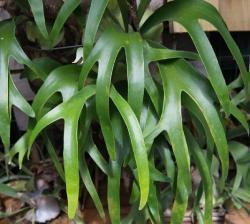When I purchased my first Staghorn Fern almost four decades ago, typically these plants were mounted and fairly large. There were no big box stores (that I can remember), so the vast majority of exotic, tropical plants were bought in mom-and-pot nurseries or greenhouses. There were numerous of these small growers/sellers along the coastal highway going from Mississippi, though Alabama, and then into the Florida panhandle. The one where my Staghorn was purchased was just off the highway between Pascagoula, MS, and Mobile, AL, and consisted of two small greenhouses. Most of the plants in these greenhouses were huge, and one literally had to push leaves and limbs aside to walk from one end to the other. The label on my plant stated that the plant was an Elkhorn Fern. The "shop" owner said that it was a Staghorn Fern but that both names fit the plant. Keep in mind there were no computers and no Web. What one learned about tropical plants was gathered word-of-mouth or from books.
After perhaps 15-20 years, that single plant grew to be one that weighed over 100 lbs. It got so large that I could no longer move it inside for the winter months and thus I had to divide it into eight plants. Those eight plants were still quite large. Even back then I was careful to label all my exotic, tropical plants, so those plants were still labeled "Elkhorn Fern".
When I moved away from the Mississippi Gulf Coast almost twenty years ago, I had no place to house my large collection of tropical plants. I donated most of them to a local nursery and to friends. I did keep one of those divisions and several other (small) tropical plants, and just kept them inside the house in Starkville, MS. A year later I built a (homemade) greenhouse and at that point began to buy and collect tropical plants again. This was 1997, and though we now had (rather crude) computers, other than for scientific purposes, the World-Wide-Web still did not exist. I still thought the Staghorn and Elkhorn were one and the same plant.
Fast-forward to 2005-2010. Personal computers were now the rage and the Web and its information were expanding quickly. I continued to purchase and propagate tropical plants and wanted my plants to be properly labeled. Researching plants became fairly simple, and the confusion about Staghorns being Elkhorns, and vice-versa was resolved. I found out that my plants were actually Staghorn Ferns and not Elkhorn Ferns. The plants I had were Platycerium bifurcatum, pretty much the standard Staghorn found for sale. Staghorn Ferns are epiphytes, and grow naturally in Africa, Madagascar, Australia, and tropical Asia. One species is found in S. America. Staghorns typically grow in trees, but a species found in Australia grows on rocky outcrops in semi-desert areas.
Though I had no Elkhorn Ferns, I found out that the most commonly found one is Polypodium grandiceps aka "Climbing Bird's Nest Fern." Whereas the Staghorn Ferns are epiphytic and (mostly) grow in trees, the Elkhorn Ferns are terrestrial, and they grow in the ground, under a canopy of tropical trees. Most Elkhorn Ferns are found (naturally) growing in the East Indies.
I now have several species of Staghorn Ferns. There are only seventeen species known to exist, making it one of the smallest genera in the entire plant kingdom! My "baby" Staghorns grow in pots, in well-draining potting soil with bark nuggets added, but when the fronds get approximately 6-8" long, I mount them so that they grow as they do in nature. I also grow and propagate the Elkhorn Fern. My Elkhorn Ferns grow in pots and/or baskets, in well-draining soil, again with some bark mixed in for better drainage/aeration.
 Staghorn Fern
Staghorn Fern
 Elkhorn Fern
Elkhorn Fern
| Thread Title | Last Reply | Replies |
|---|---|---|
| Staghorn Ferns by karenkelley | Aug 15, 2021 5:36 AM | 3 |
| Untitled by donnabking | Jan 9, 2015 10:38 PM | 6 |
| Great article! by plantladylin | Dec 28, 2014 7:23 PM | 2 |